To make available an instance of the ttk.Style() class, it was illustrated in this tkinter guide that the syntax is:
import ttk
s=ttk.Style()
When typing these command in IDLE, I noticed that ttk.Style() actually has a predefined argument, i.e.
s=ttk.Style(master=None)
I have written the following test script:
import tkinter as tk
import tkinter.ttk as ttk
class App(ttk.Frame):
def __init__(self, parent):
ttk.Frame.__init__(self, parent, style='App.TFrame', relief=tk.SUNKEN,
border=10)
self.parent = parent
self.__createStyle()
self.__createWidgets()
def __createStyle(self):
self.s = ttk.Style()
self.s.configure('.', background='orange', border=100)
self.s.configure('App.TFrame', background='yellow')
self.s.configure('Btn.TButton', background='light blue', border=10)
def __createWidgets(self):
self._label = ttk.Label(self.parent, text='Label packed in root.')
self._label.pack()
self._btn = ttk.Button(self, style='Btn.TButton', command=self.__click,
text='Button packed inside self or class App, which is a ttk.Frame')
self._btn.pack()
def __click(self):
return print('Left Button Clicked!')
class myWidget(ttk.Frame):
def __init__(self, parent):
ttk.Frame.__init__(self, parent, style='my.TFrame', relief=tk.GROOVE,
border=10)
self.parent = parent
self.__createStyle()
self.__createWidgets()
def __createStyle(self):
self.s = ttk.Style()
self.s.configure('my.TFrame', background='purple')
self.s.configure('my.TLabel', background='pink', border=10)
self.s.configure('my.TEntry', foreground='red', border=10)
def __createWidgets(self):
self._label = ttk.Label(self, style='my.TLabel',
text='myWidget Label packed in self or class myWidget, which is a ttk.Frame.')
self._label.pack()
self._entry = ttk.Entry(self, style='my.TEntry')
self._entry.pack()
if __name__ == "__main__":
root = tk.Tk()
root.title('Test Style')
root.geometry('500x150')
a = App(root)
a.pack(fill='both', expand=1)
b = myWidget(a)
b.pack()
root.mainloop()
Question 1: When do I need to declare the master arguement in ttk.Style()? E.g. in the above script, if I write self.s = ttk.Style() and self.s = ttk.Style(master=self.parent) in class myWidget, I get the same result (see Fig1).
Question 2: Is there a need to prefix s=ttk.Style() with self? I get the same result as shown in Fig1 with and without the self prefix.
Question 3: If I rename 'my.TFrame' in class myWidget as 'App.TFrame'(this name was used in class App), the background colour of the class App changed to purple color too (same color as class myWidget. Why did this happened given that variable name in different classes are unique?
Question 4: The names 'App.TFrame' and 'my.TFrame' were called before it was declared. Why did python or tkinter not complain or give an error but allowed the script to execute?
Figure 1
Figure 2

